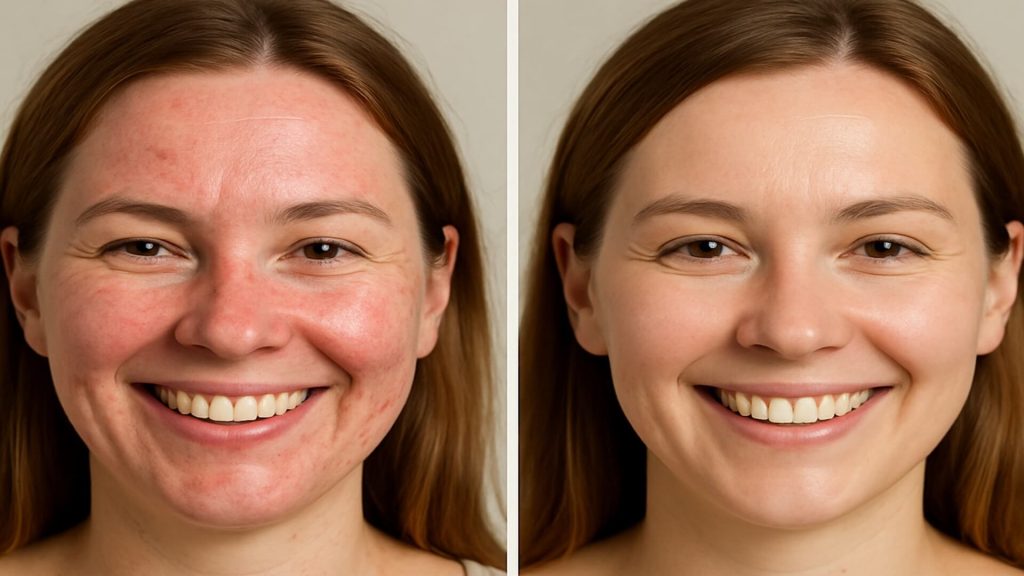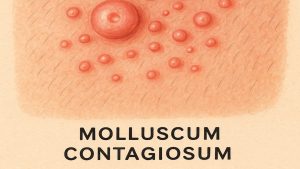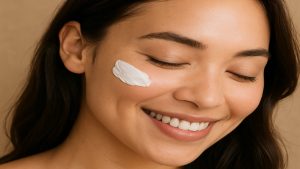- Ivermectin effectively treats parasites & some skin conditions
- Topical ivermectin calms inflammation & kills mites in weeks
- Head lice cleared in up to 95% of study participants
- Oral ivermectin achieves 68–92% cure rates for scabies
- Generally safe; 1–2% may experience mild reactions
Ivermectin is widely recognised for managing parasitic infections and dermatological conditions such as rosacea, scabies, and head lice [1,4].
This article reviews clinical findings, historical developments, and its role in modern skincare and parasitic disease control. All information presented is for educational purposes and should not replace medical advice.

What Is Ivermectin?
Discovered in 1975 by Satoshi Ōmura and William C. Campbell, ivermectin originates from Streptomyces avermitilis, a soil bacterium [1]. Initially used against river blindness (onchocerciasis), it has since become one of the most important antiparasitic medicines globally.
Available as oral tablets and topical cream, ivermectin is prescribed for both systemic and skin-related conditions, including rosacea and scabies [4,5].
Discovery & Global Impact
In the late 1970s, researchers refined avermectin into ivermectin, a safer, more effective antiparasitic agent [1]. Over 3.7 billion doses have since been distributed worldwide, significantly reducing parasitic infections in many regions [2].
Its success in public health paved the way for dermatological formulations, notably topical ivermectin 1% cream.
How Ivermectin Works
Ivermectin binds to glutamate-gated chloride channels in parasites, causing paralysis and death [3]. In skin applications, it also reduces inflammation by decreasing proinflammatory cytokines and eliminating Demodex mites, common in rosacea [4,5]. Dermatologist Dr Linda Stein Gold describes it as “a dual-action treatment that targets both inflammation and mites” [5].
Forms Of Ivermectin
| Form | Primary Use | Typical Strength |
|---|---|---|
| Oral Ivermectin Tablets | Systemic infections & scabies | 150–200 µg/kg by weight [12] |
| Topical Ivermectin Cream | Rosacea & skin infestations | 1% formulation [4,5,13,14] |
Table 1: Forms of ivermectin and their typical uses
Your healthcare professional will determine the best form depending on your condition, skin type, and treatment history.
Applications Of Topical Ivermectin
Rosacea Management
Rosacea causes facial redness and bumps often linked to Demodex mites [4,5,13,14]. Topical ivermectin helps control mites and inflammation, typically improving symptoms within 4–6 weeks.
A 2015 trial involving 1,378 participants reported significant reductions in inflammatory lesions after 12 weeks [5]. Another study found ivermectin reduced lesions by 83% compared with 73.7% for metronidazole [9].
Head Lice Treatment
Topical ivermectin lotion effectively eliminates head lice and their eggs. A 2012 NEJM study of 397 participants showed a 95.2% success rate at day 15 after a single use [6]. This formulation does not require combing and is easy to apply.
Scabies Control
Scabies mites burrow into skin, causing itching and irritation. Oral ivermectin is highly effective, achieving 68–92% cure rates with one or two doses [8]. Topical ivermectin may also help, but available data remain more limited [7].
Clinical Evidence
Robust trials confirm ivermectin’s efficacy for rosacea, lice, and scabies [4–7,13,14].
- Rosacea: 83% lesion reduction compared with 73.7% for metronidazole [9].
- Scabies: 2021 British Journal of Dermatology review supports ivermectin’s use in resistant cases [7].
- Lice: 0.5% lotion achieved up to 95% lice clearance after one application [6].
Practical Tips For Topical Use
| Condition | Frequency | Time To Results | Tip |
|---|---|---|---|
| Rosacea | Daily | 4–6 weeks | Use pea-sized amount on clean, dry skin. |
| Scabies | 1–2 doses | 48 hours | Apply evenly across body; follow medical guidance. |
| Head Lice | Once | 1–2 days | Avoid conditioners before application. |
Table 2: Practical tips for topical ivermectin use
Consistency is key for best results. Consult your healthcare provider if irritation or allergic reactions occur.
Ivermectin Safety & Side Effects
Topical and oral ivermectin are generally well tolerated. Adverse effects occur in fewer than 1–2% of users [10]. Reported side effects include mild redness or itching at the application site.
Because ivermectin does not easily cross the blood–brain barrier, neurological side effects are extremely rare [11,12]. Those pregnant or breastfeeding should consult a healthcare professional, as safety data remain limited [2].
Oral vs Topical Ivermectin
- Oral ivermectin is suited for systemic or widespread infections and scabies.
- Topical ivermectin targets localised skin conditions like rosacea or lice infestations.
Your healthcare provider can determine which form best fits your needs and check for potential interactions with other medications [12].
Key Benefits
- Demonstrated efficacy for rosacea, lice, and scabies [4–7].
- Usually well tolerated with mild, transient effects.
- Affordable and accessible globally.
- Available in both oral and topical forms for tailored treatment.
Caution is advised during pregnancy, as current research shows insufficient safety data [2].
Conclusion
Ivermectin, in both topical and oral forms, remains a well-researched option for managing certain parasitic and inflammatory skin conditions. Evidence supports its effectiveness for rosacea, scabies, and head lice, with minimal reported side effects. Consult a healthcare professional before starting treatment to ensure suitability.
For personalised skincare advice or topical prescription formulations, consider Monderma’s free consultation.
Content is for informational purposes only. Monderma treatments are prescribed following consultation. Results and timeframes can vary. Use as directed by your prescriber.
Bibliography
- The Nobel Assembly at Karolinska Institutet. The 2015 Nobel Prize in Physiology or Medicine – Press Release. 2015.
- Nicolas P, Maia MF, Bassat Q, et al. Safety of oral ivermectin during pregnancy: a systematic review and meta-analysis. The Lancet Global Health, 2020.
- Wolstenholme AJ. Glutamate-gated Chloride Channels. Journal of Biological Chemistry, 2012.
- NICE. Inflammatory lesions of papulopustular rosacea: ivermectin 10 mg/g cream. Evidence Summary ESNM68, 2016.
- Stein Gold L, Kircik L, Fowler J, et al. Ivermectin 1% cream for inflammatory lesions of rosacea. J Am Acad Dermatol, 2015.
- Pariser DM, Meinking TL, Bell M, et al. Topical 0.5% ivermectin lotion for treatment of head lice. N Engl J Med, 2012.
- NICE. Scabies: ivermectin. Clinical Knowledge Summaries, 2021.
- Chouela E, Abeldaño A, Pellerano G, et al. Equivalent therapeutic efficacy and safety of ivermectin and lindane in human scabies. Arch Dermatol, 1999.
- Taieb A, Ortonne JP, Ruzicka T, et al. Superiority of ivermectin 1% cream over metronidazole 0.75% in treating rosacea. Br J Dermatol, 2015.
- Campillo JT, Boussinesq M, Bertout S, et al. Serious adverse reactions associated with ivermectin: a pharmacovigilance study. PLoS Negl Trop Dis, 2021;15(4):e0009354.
- Guzzo CA, Furtek CI, Porras AG, et al. Safety, tolerability, and pharmacokinetics of escalating doses of ivermectin. J Clin Pharmacol, 2002.
- Merck & Co. Stromectol (ivermectin) prescribing information. 2009.
- Walker S, Cassia A, Lanza M, et al. Efficacy and safety of topical ivermectin for rosacea: a systematic review. Br J Dermatol, 2021.
- Gether L, Overgaard LK, Egeberg A, Thyssen JP. Topical ivermectin for papulopustular rosacea: review of clinical evidence. Dermatol Ther, 2018;8(3):379–387.
Find your perfect skincare formula
Takes less than 2 minutes – see what your skin needs
Get Custom Formula













